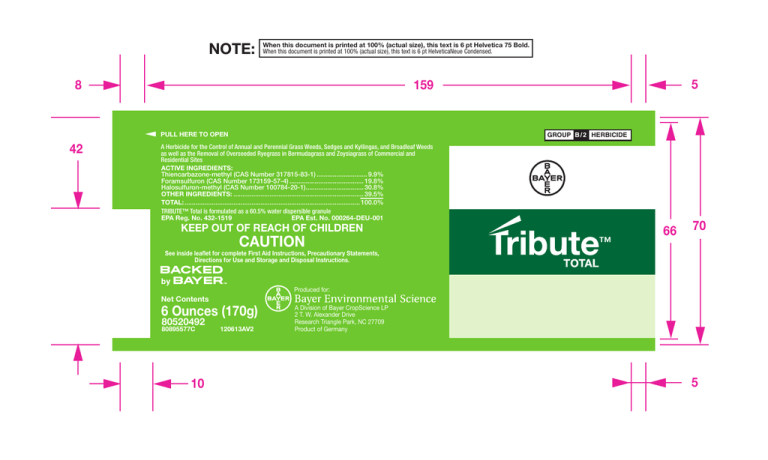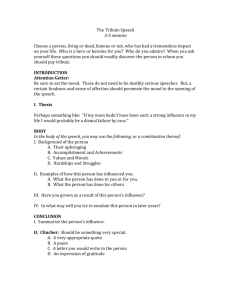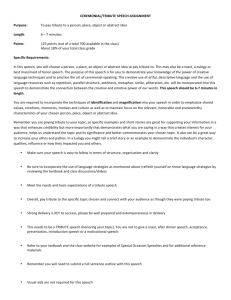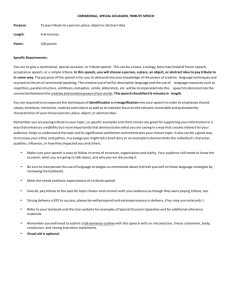Tribute Total Label
advertisement

NOTE: When this document is printed at 100% (actual size), this text is 6 pt Helvetica 75 Bold. When this document is printed at 100% (actual size), this text is 6 pt HelveticaNeue Condensed. 8 PULL HERE TO OPEN 42 5 159 GROUP B / 2 HERBICIDE A Herbicide for the Control of Annual and Perennial Grass Weeds, Sedges and Kyllingas, and Broadleaf Weeds as well as the Removal of Overseeded Ryegrass in Bermudagrass and Zoysiagrass of Commercial and Residential Sites ACTIVE INGREDIENTS: Thiencarbazone-methyl (CAS Number 317815-83-1) ............................ 9.9% Foramsulfuron (CAS Number 173159-57-4) ......................................... 19.8% Halosulfuron-methyl (CAS Number 100784-20-1)................................ 30.8% OTHER INGREDIENTS: ........................................................................ 39.5% TOTAL: ................................................................................................. 100.0% TRIBUTE™ Total is formulated as a 60.5% water dispersible granule EPA Reg. No. 432-1519 EPA Est. No. 000264-DEU-001 KEEP OUT OF REACH OF CHILDREN CAUTION 66 70 See inside leaflet for complete First Aid Instructions, Precautionary Statements, Directions for Use and Storage and Disposal Instructions. Produced for: Net Contents 6 Ounces (170g) 80520492 80895577C 10 120613AV2 A Division of Bayer CropScience LP 2 T. W. Alexander Drive Research Triangle Park, NC 27709 Product of Germany 5 Tribute Total 80895577C 120613AV2 leaflet 040413:Tribute Total 80895577C 120613AV2 leaflet 040413 4/4/13 10:26 AM Page 1 For MEDICAL and TRANSPORTATION Emergencies ONLY Call 24 Hours A Day 1-800-334-7577 For PRODUCT USE Information Call 1-800-331-2867 FIRST AID If swallowed: • Call a poison control center or doctor immediately for treatment advice. • Have person sip a glass of water if able to swallow. • Do not induce vomiting unless told to do so by a poison control center or doctor. • Do not give anything to an unconscious person. If in eyes: • Hold eyes open and rinse slowly and gently with water for 15-20 minutes. • Remove contact lenses, if present, after the first 5 minutes, then continue rinsing. • Call a poison control center or doctor for treatment advice. If on skin or clothing: • Take off contaminated clothing. • Rinse skin immediately with plenty of water for 15-20 minutes. • Call a poison control center or doctor for treatment advice. A Herbicide for the Control of Annual and Perennial Grass Weeds, Sedges and Kyllingas, and Broadleaf Weeds as well as the Removal of Overseeded Ryegrass in Bermudagrass and Zoysiagrass of Commercial and Residential Sites ACTIVE INGREDIENTS: Thiencarbazone-methyl (CAS Number 317815-83-1)...........................................9.9% Foramsulfuron (CAS Number 173159-57-4) ........................................................19.8% Halosulfuron-methyl (CAS Number 100784-20-1) ..............................................30.8% OTHER INGREDIENTS: .........................................................................................39.5% TOTAL: 100.0% TRIBUTE™ Total is formulated as a 60.5% water dispersible granule EPA Reg No. 432-1519 EPA Est. No. 000264-DEU-001 KEEP OUT OF REACH OF CHILDREN Have the product container or label with you when calling a poison control center or doctor or going for treatment. CAUTION See inside leaflet for complete First Aid Instructions, Precautionary Statements, Directions for Use and Storage and Disposal Instructions. Produced for: Net Contents 6 Ounces (170g) 80520492 80895577C 120613AV2 A Division of Bayer CropScience LP 2 T. W. Alexander Drive Research Triangle Park, NC 27709 Tribute Total 80895577C 120613AV2 leaflet 040413:Tribute Total 80895577C 120613AV2 leaflet 040413 4/4/13 10:26 AM Page 2 FIRST AID If swallowed: If in eyes: If on skin or clothing: • long-sleeved shirt and long pants • shoes plus socks Follow manufacturer’s instructions for cleaning/maintaining PPE. If no such instructions for washables exist, use detergent and hot water. Keep and wash PPE separately from other laundry. • Call a poison control center or doctor immediately for treatment advice. • Have person sip a glass of water if able to swallow. • Do not induce vomiting unless told to do so by a poison control center or doctor. • Do not give anything to an unconscious person. ENGINEERING CONTROLS STATEMENTS: When handlers use closed systems or enclosed cabs in a manner that meets the requirements listed in the Worker Protection Standard (WPS) for agricultural pesticides [40 CFR 170.240 (d) (4-6)], the handler PPE requirements may be reduced or modified as specified in the WPS. • Hold eyes open and rinse slowly and gently with water for 15-20 minutes. • Remove contact lenses, if present, after the first 5 minutes, then continue rinsing. • Call a poison control center or doctor for treatment advice. User Safety Recommendations Users should remove clothing/PPE immediately if pesticide gets inside. Then wash thoroughly and put on clean clothing. Users should remove PPE immediately after handling this product. As soon as possible, wash thoroughly and change into clean clothing. • Take off contaminated clothing. • Rinse skin immediately with plenty of water for 15-20 minutes. • Call a poison control center or doctor for treatment advice. ENVIRONMENTAL HAZARDS Have the product container or label with you when calling a poison control center or doctor or going for treatment. Do not apply directly to water, to areas where surface water is present or to intertidal areas below the mean high water mark. Do not contaminate water when cleaning equipment or disposing of equipment washwaters and rinsate. Do not drain or rinse equipment near desirable vegetation. Do not apply when conditions favor drift from treated areas. Non-target plants may be adversely affected if the pesticide is allowed to drift from areas of application. To prevent damage to crops and other desirable plants, read and follow all directions and precautions on this label before using. This product may impact surface water quality due to runoff of rain water. This is especially true for poorly draining soils and soils with shallow ground water. This product is classified as having “high potential for reaching surface water via runoff,” according to the chemical’s “mean” soil partition coefficient (Kd) for several days after application. A level well-maintained vegetative buffer strip between areas to which this product is applied and surface water features such as ponds, streams, and springs will reduce the potential loading of this herbicide from runoff water PRECAUTIONARY STATEMENTS HAZARDS TO HUMANS AND DOMESTIC ANIMALS CAUTION Harmful if swallowed. Causes moderate eye irritation. Avoid contact with eyes or clothing. Wash thoroughly with soap and water after handling and before eating, drinking, chewing gum, using tobacco or using the toilet. PERSONAL PROTECTIVE EQUIPMENT (PPE) Some of the materials that are chemical-resistant to this product are listed below. If you want more options, follow the instructions for category A on an EPA chemical-resistance category selection chart. All mixers, loaders, applicators and other handlers must wear: 1 Tribute Total 80895577C 120613AV2 leaflet 040413:Tribute Total 80895577C 120613AV2 leaflet 040413 4/4/13 10:26 AM Page 3 and sediment. Runoff of this product will be reduced by avoiding applications when rainfall is forecasted to occur within 48 hours. Some of the chemicals in this product have properties and characteristics associated with chemicals detected in ground water. These chemicals may leach into ground water if used in areas where soils are permeable, particularly where the water table is shallow. NON AGRICULTURAL USE REQUIREMENTS The requirements in this box apply to uses of this product that are not within the scope of the Worker Protection Standard for agricultural pesticides (40 CFR Part 170). The WPS applies when this product is used to produce agricultural plants on farms, forests, nurseries, or greenhouses. Keep unprotected persons out of the treated areas until sprays have dried. DIRECTIONS FOR USE It is a violation of Federal Law to use this product in a manner inconsistent with its labeling. Read entire label before using this product. Do not apply this product in a way that will contact workers or other persons, either directly or through drift. Only protected handlers may be in the area during application. For any requirements specific to your State or Tribe, consult the agency responsible for pesticide regulation. STORAGE AND DISPOSAL Do not contaminate water, food or feed by storage or disposal. PESTICIDE STORAGE Store in original container only. Store in a manner to prevent cross-contamination of other pesticides, fertilizer, food and feed. Do not store in or around the home. Store in a dry, locked storage area. PESTICIDE DISPOSAL Wastes resulting from the use of this product must be disposed of on site or at an approved waste disposal facility. CONTAINER HANDLING Non-refillable container. Do not reuse or refill this container. Offer for recycling, if available. Triple rinse container (or equivalent) promptly after emptying. Triple rinse as follows: Empty the remaining contents into application equipment or a mix tank and drain for 10 seconds after the flow begins to drip. Fill the container ¼ full with water and recap. Shake for 10 seconds. Pour rinsate into application equipment or a mix tank or store rinsate for later use or disposal. Drain for 10 seconds after the flow begins to drip. Repeat this procedure two more times. Then puncture and dispose of in a sanitary landfill or by other procedures approved by State and local authorities. AGRICULTURAL USE REQUIREMENTS Use this product only in accordance with its labeling and with the Worker Protection Standard, 40 CFR part 170. This standard contains requirements for the protection of agricultural workers on farms, forests, nurseries, and greenhouses, and handlers of agricultural pesticides. It contains requirements for training, decontamination, notification, and emergency assistance. It also contains specific instructions and exceptions pertaining to the statements on this label about personal protective equipment (PPE) and restricted-entry intervals. The requirements in this box only apply to uses of this product that are covered by the Worker Protection Standard. Do not enter or allow worker entry into treated areas during the restricted entry interval (REI) of 12 hours. PPE required for early entry to treated areas that is permitted under the Worker Protection Standard and that involves contact with anything that has been treated, such as plants, soil, or water, is coveralls over long-sleeved shirt and long pants, shoes plus socks, and chemical-resistant gloves made out of any waterproof material. 2 Tribute Total 80895577C 120613AV2 leaflet 040413:Tribute Total 80895577C 120613AV2 leaflet 040413 4/4/13 10:26 AM Page 4 APPLICATION METHODS PRODUCT INFORMATION PRODUCT USES SPRAY SOLUTION pH The efficacy of TRIBUTE TOTAL may be affected by the pH of the spray solution. A pH near 6 is ideal. If pH is greater than 6, add a spray buffer. SPRAY VOLUME For broadcast applications, use a minimum of 10 gallons of water per acre. For weed control in dense weed populations, control of weeds under adverse growing conditions, or control of mature weeds, higher spray volumes up to 60 gallons per acre should be used. TRIBUTE TOTAL requires a spray adjuvant. For maximum weed control, use the spray adjuvant(s) as specified in the ‘WEEDS CONTROLLED’ section of this label. TRIBUTE™ TOTAL is a selective, post-emergent herbicide for the control of annual and perennial grass weeds, sedges and kyllingas, and broadleaf weeds growing in well-established bermudagrass and zoysiagrass turf. TRIBUTE TOTAL can also be used as a transition aid for the removal of overseeded cool season grasses from bermudagrass and zoysiagrass. TRIBUTE TOTAL is for use only on commercial and residential turf including golf courses (excluding greens and overseeded tees), residential and commercial lawns, sports fields, cemeteries, parks, campgrounds, recreational areas, roadsides, school grounds, and sod farms. SYMPTOMOLOGY Weed growth is inhibited within hours after application yet visible symptoms typically require 1 or more weeks before becoming evident – the meristematic regions become chlorotic followed by slow, general foliar color changes and necrosis. Eventual plant death usually occurs within 1 to 4 weeks after treatment. The speed of symptom development varies with temperature and will be faster at warmer temperatures. MODE OF ACTION The active ingredients found in TRIBUTE TOTAL inhibit the protein acetolactate synthase (ALS), also known as acetohydroxyacid synthase (AHAS). The ALS enzyme catalyzes the first step in the biosynthesis of the essential branched chain amino acids (valine, leucine, and isoleucine). The lowered levels of ALS enzyme and branched chain amino acids trigger further biochemical events culminating in the death of the weed. RESISTANCE MANAGEMENT Some weed species have naturally occurring biotypes within their population which are resistant to ALS-inhibiting herbicides (Group B/2 Herbicides). Repeated application of an ALS herbicide may select for these resistant weed biotypes. To prevent or delay the build up of ALS resistant weeds, always use the prescribed herbicide rate and application timing for the hardest to control weed species present in the field. PRODUCT USE RATES To Treat 1 Acre To Treat 1,000 Square Feet oz/Acre Tribute Measuring Spoon oz/1,000 sq ft 1 2 1 ml 2 ml 0.023 0.046 3 3.2 3 ml 3.2 ml 0.069 0.073 6.4 6.4 ml 0.147 Comments Single Broadcast Application Maximum Yearly Maximum SPOT TREATMENTS Spot Treatments are for controlling individual weeds and/or small areas of weeds. To make a Spot Treatment, mix 0.023 oz. – 0.073 oz of TRIBUTE TOTAL per gallon of water and add appropriate spray adjuvant(s). Spray weeds until wet but avoid spray solution runoff and over application. Spot treatments are likely to cause yellowing and growth regulatory effects to the turfgrass. For spot treatments, treat no more than 10,000 sq. ft. per acre. 3 Tribute Total 80895577C 120613AV2 leaflet 040413:Tribute Total 80895577C 120613AV2 leaflet 040413 4/4/13 10:26 AM Page 5 or WG (this product) > DF > F > EC > SP or SC. 5. Finally, add the spray adjuvant and liquid fertilizer, if desired. Finish filling the spray tank with water to the desired volume. 6. Continue agitation during application to ensure a uniform spray mixture. If this product is to be tank-mixed with other products, compatibility should be tested prior to mixing and turf tolerance should be tested prior to use. To test for compatibility, use a small container and mix a small amount (1/2 to 1 quart) of spray, combining all ingredients in the same ratio as the anticipated use. If any indications of physical incompatibility develop (e.g., precipitation, settling, color change), do not use this mixture for spraying. Indications of incompatibility may occur within 5 to 15 minutes after mixing. To test for turf tolerance, apply the tank mix at the specified rate to a small area that can tolerate damage and monitor visually for turf damage over several weeks. If damage is unacceptable, do not apply TRIBUTE TOTAL. Read and follow the precautionary statements, directions for use, and restrictions of each tank mix product. The most restrictive language applies. APPLICATION Uniform, thorough spray coverage is important to achieve consistent weed control. Select spray nozzles and pressure that deliver MEDIUM spray droplets as indicated in nozzle manufacturers’ catalogs and in accordance with ASABE Standard S-572.1. Nozzles that deliver COARSE spray droplets may be used to reduce spray drift provided spray volume per acre (GPA, Gallons Per Acre) is increased to maintain coverage of weeds. PRECAUTIONS 1. Rainfall within the first 3 hours after treatment may require retreatment with this product or reduced weed control may result. 2. Make applications to actively growing weeds. Mature, hardened-off weeds may not be controlled. Weed control may be reduced if application is made in the presence of heavy dew, fog, and mist/rain or when weeds are under stress due to drought. 3. Apply spray mixtures of this product within 48 hours of mixing to avoid product degradation. 4. Avoid excessive mechanical disruptions such as aerification and verticutting within 1 week prior to or after application of TRIBUTE TOTAL. RESTRICTIONS 1. Do not apply more than 3.2 oz of product per acre in one application. Do not apply more than a SPRAY ADJUVANTS TRIBUTE TOTAL requires a spray adjuvant. For maximum weed control, use the spray adjuvant(s) as specified in the ‘WEEDS CONTROLLED’ section of this label. These additives may also cause phytotoxicity to desirable turfgrasses under some situations. Test their use in a limited area that can tolerate damage and visually monitor for turf tolerance over several weeks prior to widespread use. • Use 0.25 to 0.5% v/v of a Nonionic Surfactant (NIS) that is at least 80% active material and does NOT contain an organosilicone surfactant. Do not exceed 1 quart of NIS per acre as turf injury may result. • OR, instead of an NIS, use 0.5 to 1% v/v of a methylated seed oil (MSO) containing at least 80% methylated seed oil and 10% or greater emulsifier (up to 1% v/v). Other MSO blends must be tested before use. • Do not use crop oil concentrates (COC), COC plus methylated seed oil blends, or refined vegetable oils with TRIBUTE TOTAL. • The addition of ammonium sulfate (AMS) has been shown to improve efficacy. Use spray grade AMS (1 1/2 to 3 lb/acre) for areas of high relative humidity or use urea ammonium nitrate (UAN) (1 1/2 to 2 Qt/acre) in areas of low relative humidity. • Use the higher rates of NIS or MSO with higher spray volumes. • In areas with hard water, use the addition of ammonium sulfate (AMS) or urea ammonium nitrate (UAN). Always read and follow the spray adjuvant label directions prior to use and observe all precautions, mixing and application instructions. MIXING INSTRUCTIONS TRIBUTE TOTAL must be applied with clean and properly calibrated equipment. Prior to adding TRIBUTE TOTAL, ensure that the spray tank, filters, and nozzles have been thoroughly cleaned. 1. Fill spray tank with ¼ to ½ the required volume of water. 2. Begin agitation prior to the addition of TRIBUTE TOTAL and continue throughout this entire mixing process (Steps 2. – 6.) 3. Add TRIBUTE TOTAL. Once it is fully dispersed, resume adding water to the desired volume. 4. If TRIBUTE TOTAL is to be applied in a tank mixture with other pesticides, the general order of addition for pesticides, by product form is, from first-in-spray-tank to last-in-spray-tank: WP 4 Tribute Total 80895577C 120613AV2 leaflet 040413:Tribute Total 80895577C 120613AV2 leaflet 040413 4/4/13 10:26 AM Page 6 total of 6.4 oz of product per acre (0.147 oz of product per 1,000 sq ft) per year. 2. Do not apply this product by air or through any type of irrigation system. 3. Apply this product only to well-established turf unless noted otherwise on this label. 4. Do not apply this product on turf under stress from drought, insects, disease, cold temperatures, or poor fertility as injury may result. 5. Do not apply this product on turf exhibiting injury from previous applications of other products. 6. In order to minimize risk to sensitive areas (water bodies or non-target plants), apply by broadcast application (boom-type sprayers) only when the potential for drift to adjacent sensitive areas is minimal (e.g., when the wind is 10 mph or less and is blowing away from the sensitive area and maintain a 25-ft buffer between the point of direct application and the closest downwind edge of adjacent sensitive areas). 7. Do not use this product on these grasses: bahiagrass, buffalograss, centipedegrass, kikuyugrass, St. Augustinegrass, or seashore paspalum and cool season turf types, including tall fescue, fine fescue, Kentucky bluegrass, perennial ryegrass, annual ryegrass, or creeping bentgrass. 8. Do not apply this product when wind causes drift to off-site vegetation as injury may occur. 9. Do not use this product for grasses grown for seed. TURF TOLERANCE This product was tested and can be used on the following types of warm season turfgrasses and their cultivars. Some temporary stunting of growth and discoloration (yellowing) may occur and last up to 2 weeks after treatment but the turf will recover. When bermudagrass top growth is slowed (e.g., due to plant growth regulator or environmental effects), these symptoms may take longer to develop, may take longer to subside, and/or may be accentuated. Bermudagrass (Common, Tifway 419, Tifsport, Vamont, Tifgreen 328) Zoysiagrass (Emerald, Meyer, Zeon) Do not use TRIBUTE TOTAL on pure stands or mixtures of bermudagrass or zoysiagrass not listed on this label without first testing for adequate turf tolerance. To test, apply TRIBUTE TOTAL at the specified rate to a small plot representative of the larger area to be treated. Visually monitor for turf damage up to 2 weeks. If damage is unacceptable, do not apply TRIBUTE TOTAL. SEEDING AND SPRIGGING INTERVALS Perennial and annual ryegrass – Do not apply TRIBUTE TOTAL within 8 weeks prior to overseeding. If applications are made within this window, a reduced stand will occur. Seeded Bermudagrass or Zoysiagrass – TRIBUTE TOTAL may be applied to bermudagrass or zoysiagrass up to 3 months [90 days] prior to seeding without a significant reduction in stand. For newly established stands of bermudagrass or zoysia, do not apply TRIBUTE TOTAL for at least one month [4 weeks] after emergence since injury may result. Sprigged / Sodded Bermudagrass or Zoysiagrass – TRIBUTE TOTAL may be applied no sooner than 2 weeks aftersprigging or sodding without a significant reduction in quality. USE OF TRIBUTE TOTAL NEAR SENSITIVE GRASSES TRIBUTE TOTAL will control cool season grasses. Some use sites, including many golf courses, grow different turf types in the same vicinity e.g., bentgrass greens or overseeding in warm season turf. To reduce the possibility of TRIBUTE TOTAL being carried from its application site to adjoining areas with sensitive grasses, practice the following within the first 48 hours after application: • Allow the treated area adjacent to sensitive grasses to dry before opening to traffic (foot traffic, mowing, etc.) • If dew is present, irrigate lightly (0.1 to 0.2 inch) prior to allowing traffic onto cool season turf. Do not overwater as this could result in reduced weed control. • If the preceding practices cannot be achieved, maintain a 15 ft untreated buffer to reduce the risk of tracking from the application site onto sensitive grasses. • When there may be a risk to adjacent sensitive grasses, apply TRIBUTE TOTAL when the soil is less than field capacity. Avoid applications to saturated soil. TANK MIX PARTNERS When using TRIBUTE TOTAL in tank mix combinations, follow the precautions and directions of the most restrictive label. Test compatibility with other unlisted pesticides prior to use. When tank-mixing with other products, it is the responsibility of the end-user applicator to ensure that the tank-mix partner is registered in the state where the application is being made. Applications of TRIBUTE TOTAL can be made in conjunction with a pre-emergent herbicide, such as Specticle® 20 WSP Herbicide, Specticle FLO Herbicide, Ronstar® FLO Herbicide, or Ronstar WSP Herbicide, to obtain pre-emergent and post-emergent activity. Always follow the most restrictive overseeding interval for the products used. TRIBUTE TOTAL may be combined with Illoxan® 3EC Herbicide, or Sencor® 75% Turf Herbicide, to ex5 Tribute Total 80895577C 120613AV2 leaflet 040413:Tribute Total 80895577C 120613AV2 leaflet 040413 4/4/13 10:26 AM Page 7 pand the post-emergent weed control spectrum. Not all products are registered in all states; please verify state registration of tank mix partners in your state before selling, distributing, or using. SPRAY EQUIPMENT CLEANUP 1. Drain the tank completely, then wash out tank, boom and hoses with clean water. Drain again. 2. Fill the tank half full with clean water and add EITHER a commercial tank cleaner OR an appropriate detergent, being certain to carefully follow manufacturer’s use directions. Completely fill the tank with water. Agitate/recirculate and flush through boom and hoses. Leave agitation on for 10 minutes. Drain tank completely. 3. Repeat Step 2. 4. Remove nozzles and screens and soak them in the cleaning solution. Inspect nozzles and screens and remove visible residues. 5. Flush tank, boom, and hoses with clean water. 6. Inspect tank for visible residues. If present, repeat Step 2. WEEDS CONTROLLED DALLISGRASS Dallisgrass (Paspalum dilatatum) is a difficult-to-control, warm-season, rhizomatous, perennial grass weed. Best control is achieved with TRIBUTE TOTAL when applied in the late summer / early fall while the weed is still actively growing and not under stress (e.g., water stress/drought conditions). Applying a systemic herbicide, such as TRIBUTE TOTAL, during this period promotes movement of the active ingredients down to the roots, aiding in effective control. For post-emergent control of dallisgrass in well-established bermudagrass and zoysiagrass, use TRIBUTE TOTAL at 3.2 oz/acre and include the addition of a methylated seed soil (MSO) and ammonium sulfate. Make an application in the late summer / early fall while the weeds are still actively growing and not under stress (e.g., water stress/drought conditions). Follow up with a second application approximately 4 to 6 weeks later when the dallisgrass begins to recover. Good control is sometimes not observed immediately after application but will become apparent the following spring when untreated dallisgrass greens up. Applications outside the ideal timing will provide dallisgrass suppression. For optimum control, follow guidelines for late summer / early fall application. SEDGES & KYLLINGAS For post-emergent control of purple nutsedge (Cyperus rotundus) and yellow nutsedge (C. esculentus), up to and including the 8 leaf growth stage, and for post-emergent control and/or suppression of Kyllinga species in well-established bermudagrass and zoysiagrass, use 3.2 oz/acre TRIBUTE TOTAL plus a Nonionic Surfactant (NIS). The addition of ammonium sulfate will further improve control. A second application may be required 6 to 10 weeks after the initial treatment. Treat new plants as they emerge from existing tubers / nutlets. TRANSITIONING OVERSEEDED BERMUDAGRASS FAIRWAYS, & ROUGHS Treatments should be applied when removal of ryegrass is desired and bermudagrass has resumed growth to ensure fill in. TRIBUTE TOTAL use rate and local temperatures will influence the speed of removal – higher product rates and warmer spring temperatures result in faster removal. The best time for application within the transition period will vary by location. Addition of nitrogen fertilizer in the tank mixture at the time of application may improve turf quality by increasing bermudagrass growth during transition. GOOSEGRASS For fair to excellent control of goosegrass (Eleusine indica), up to and including early tiller stages, in well-established bermudagrass and zoysiagrass, use TRIBUTE TOTAL at 3.2 oz/acre and include the addition of a methylated seed oil (MSO) and ammonium sulfate. Make a repeat application when necessary approximately 4 to 6 weeks after the first application. To prevent new goosegrass plants from emerging, apply this product as a tank mixture with Specticle 20 WSP or Specticle FLO Herbicide. CRABGRASS TRIBUTE TOTAL, when applied at 3.2 oz/acre with a spray adjuvant, will control large crabgrass (Digitaria sanguinalis) and smooth crabgrass (Digitaria ischaemum) in well-established bermudagrass and zoysiagrass when the application is made from emergence to two tiller stage. Make a second application if necessary approximately 4 to 6 weeks later. Make additional applications to newly germinated crabgrass. Where crabgrass is in multi-tillered stages, multiple applications may be needed to achieve optimum results. VIRGINIA BUTTONWEED Virginia buttonweed (Diodia virginiana) is a difficult-to-control herbaceous, perennial dicot weed. To 6 Tribute Total 80895577C 120613AV2 leaflet 040413:Tribute Total 80895577C 120613AV2 leaflet 040413 4/4/13 10:26 AM Page 8 treat, apply TRIBUTE TOTAL at 3.2 oz/acre plus MSO plus AMS at late spring / early summer timing. Make a repeat application when regrowth occurs, approximately 4 – 6 weeks after initial treatment. DOVEWEED Doveweed (Murdannia nudiflora) is a summer annual broadleaf weed that closely resembles a grass. Germination begins later in the summer and continues until early fall. Post emergent herbicides, such as TRIBUTE TOTAL, are typically held back until the weed population has grown to a moderate level – this typically occurs around late July / early August – since new weeds will continue to emerge after the herbicide is applied and they won’t be controlled. Tribute Total provides fair to excellent control of existing doveweed plants when applied at 3 oz/acre plus MSO and AMS. Make a repeat application when regrowth occurs. The addition of a pre-emergent herbicide, such as Specticle FLO, will extend control by preventing emergence of newly germinated weeds. OTHER GRASS WEEDS AND BROADLEAF WEEDS Grass weeds and broadleaf weeds are best controlled while young and actively growing. This is the best time to apply TRIBUTE TOTAL. Always include a spray adjuvant. Weeds are difficult to control when mature and/or undergoing environmental stress, such as hot temperatures or drought. Herbicide applications made at this time usually result in poor weed control and increased risk of damage to desirable plants, such as the turf. Larger and/or mature weeds may require a higher rate (up to 3.2 oz/A) or sequential applications. Weeds controlled at 2 oz TRIBUTE TOTAL per acre Common Name Barley, Little Weeds controlled at 1 oz TRIBUTE TOTAL per acre Common Name Scientific Name Bentgrass, Creeping Agrostis stolonifera Bluegrass, Annual Poa annua Bluegrass, Roughstalk Ryegrass - Transition Poa trivialis Lolium spp. 7 Scientific Name Hordeum pusillum Carpetweed (Indian chickweed) Mollugo verticillata Chickweed, Common Chickweed, Mouseear Clover, Hop Clover, Rabbitfoot Clover, White Stellaria media Cerastium vulgatum Trifolium spp. Trifolium arvense Trifolium repens Common vetch Cudweed Vicia sativa Gnaphalium, Pseudognaphalium, and Gamochaeta spp. Cutleaf evening primrose Oenothera laciniata Dandelion, Carolina false Fescue, Tall Florida pusley Hairy bittercress Henbit Pyrrhopappus carolinianus Schedonorus phoenix (Festuca arundinacea) Richardia scabra Cardamine hirsuta Lamium amplexicaule Knawel Scleranthus annuus (cont.) Tribute Total 80895577C 120613AV2 leaflet 040413:Tribute Total 80895577C 120613AV2 leaflet 040413 4/4/13 10:26 AM Page 9 Weeds controlled at 3 oz TRIBUTE TOTAL per acre Weeds controlled at 2 oz TRIBUTE TOTAL per acre (cont.) Common Name London rocket Scientific Name Sisymbrium irio Common Name Cocklebur, Common Doveweed Scientific Name Xanthium strumarium Murdannia nudiflora Plantain, Buckhorn Plantago lanceolata Plantain, Paleseed Plantago virginica Ryegrass - Volunteer or ‘Clumpy’ Lolium spp. Fleabane, Philadelphia Mallow, Venice Erigeron philadelphicus Hibiscus trionum Shepherdspurse Capsella bursa-pastoris Passionflower, Maypop Passiflora incarnata Speedwell, Corn Veronica arvensis Pigweed, Redroot Amaranthus retroflexus Texas toadflax Nuttallanthus texanus (Linaria canadensis var. texana, Linaria texana) Pokeweed, Common Phytolacca americana 8 Radish, Wild Raphanus raphanistrum Ragweed, Common Ambrosia artemisiifolia Ragweed, Giant Ambrosia trifida Smartweed, Pennsylvania Polygonum pensylvanicum Sunflower, Common Helianthus annus Velvetleaf Abutilon theophrasti Tribute Total 80895577C 120613AV2 leaflet 040413:Tribute Total 80895577C 120613AV2 leaflet 040413 4/4/13 10:26 AM Page 10 SPRAY DRIFT MANAGEMENT Damage to sensitive, non-targeted plants may occur as a result of spray drift. Spray drift can be managed by several application factors and by spraying under appropriate environmental conditions. Consequently, avoidance of spray drift is the responsibility of the applicator. Sensitive Areas: Apply by broadcast application (boom-type sprayers) only when the potential for drift to adjacent sensitive areas (water bodies or non-target plants) is minimal (e.g., when wind is 10 mph or less and is blowing away from the sensitive areas). Avoiding spray drift at the application site is the responsibility of the applicator. The interaction of many equipment and weather related factors determines the potential for spray drift. The applicator and the grower are responsible for considering all these factors when making decisions. Do not apply under circumstances where possible drift to unprotected persons or to food, forage, desirable plants, or crops intended for sale, use, or consumption. Droplet Size: Applying larger droplets reduces drift potential, but will not prevent drift if applications are made improperly, or under unfavorable environmental conditions (see Temperature and Humidity below). Select nozzles and pressure that deliver at least MEDIUM-sized spray droplets as indicated in nozzle manufacturer’s catalogs and in accordance with ASABE Standard S-572.1. Higher flow rate nozzles generally deliver larger droplet size and can help reduce drift potential. Nozzles that deliver COARSE spray droplets may be used to reduce spray drift provided spray volume per acre (Gallons Per Acre, GPA) is increased to maintain coverage of weeds. Application Height: To minimize spray drift, apply with nozzle height no more than 3 feet above the ground. Temperature and Humidity: When making applications in low relative humidity, set up equipment to produce larger droplets to compensate for evaporation. Droplet evaporation is most severe under hot and dry conditions. Avoid spraying during conditions of high temperatures and/or low humidity. Weeds controlled at 3.2 oz TRIBUTE TOTAL per acre Common Name Bahiagrass (suppression) Buttonweed, Virginia Scientific Name Paspalum notatum Diodia virginiana Carolina Geranium Crabgrass, Large (Hairy crabgrass) Geranium carolinianum Digitaria sanguinalis Crabgrass, Smooth Digitaria ischaemum Dallisgrass Paspalum dilatatum Dollarweed (Pennywort) Hydrocotyle spp. Goosegrass Eleusine indica Kyllinga Kyllinga spp. Nutsedge, Yellow Cyperus esculentus Nutsedge, Purple Cyperus rotundus Parsley-piert Aphanes microcarpa (Alchemilla microcarpa) Spurge, Garden Chamaesyce hirta (Euphorbia hirta) Spurge, Spotted Chamaesyce maculata Woodsorrel, Yellow Oxalis stricta IMPORTANT: READ BEFORE USE Read the entire Directions for Use, Conditions, Disclaimer of Warranties and Limitations of Liability before using this product. If terms are not acceptable, return the unopened product container at once. By using this product, user or buyer accepts the following Conditions, Disclaimer of Warranties and Limitations of Liability. CONDITIONS: The directions for use of this product are believed to be adequate and must be followed 9 Tribute Total 80895577C 120613AV2 leaflet 040413:Tribute Total 80895577C 120613AV2 leaflet 040413 4/4/13 10:26 AM Page 11 carefully. However, it is impossible to eliminate all risks associated with the use of this product. Crop injury, ineffectiveness or other unintended consequences may result because of such factors as weather conditions, presence of other materials, or the manner of use or application, all of which are beyond the control of Bayer CropScience LP. All such risks shall be assumed by the user or buyer. DISCLAIMER OF WARRANTIES: TO THE EXTENT CONSISTENT WITH APPLICABLE LAW, BAYER CROPSCIENCE LP MAKES NO OTHER WARRANTIES, EXPRESS OR IMPLIED, OF MERCHANTABILITY OR OF FITNESS FOR A PARTICULAR PURPOSE OR OTHERWISE, THAT EXTEND BEYOND THE STATEMENTS MADE ON THIS LABEL. No agent of Bayer CropScience LP is authorized to make any warranties beyond those contained herein or to modify the warranties contained herein. TO THE EXTENT CONSISTENT WITH APPLICABLE LAW, BAYER CROPSCIENCE LP DISCLAIMS ANY LIABILITY WHATSOEVER FOR SPECIAL, INCIDENTAL OR CONSEQUENTIAL DAMAGES RESULTING FROM THE USE OR HANDLING OF THIS PRODUCT. LIMITATIONS OF LIABILITY: TO THE EXTENT CONSISTENT WITH APPLICABLE LAW THE EXCLUSIVE REMEDY OF THE USER OR BUYER FOR ANY AND ALL LOSSES, INJURIES OR DAMAGES RESULTING FROM THE USE OR HANDLING OF THIS PRODUCT, WHETHER IN CONTRACT, WARRANTY, TORT, NEGLIGENCE, STRICT LIABILITY OR OTHERWISE, SHALL NOT EXCEED THE PURCHASE PRICE PAID, OR AT BAYER CROPSCIENCE LP’S ELECTION, THE REPLACEMENT OF PRODUCT. Bayer (reg’d), the Bayer Cross (reg’d), Illoxan®, Ronstar®, Sencor®, Specticle®, Tribute™ and Backed by Bayer™ are trademarks of Bayer. 10 Tribute Total 80895577C 120613AV2 leaflet 040413:Tribute Total 80895577C 120613AV2 leaflet 040413 4/4/13 10:26 AM Page 12 11




